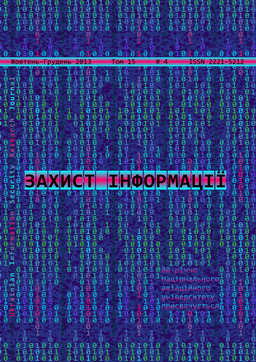Image steganography method based on complementary image
DOI:
https://doi.org/10.18372/2410-7840.15.5727Keywords:
steganography, complementary image, Latin squaresAbstract
Abstract. Digital images while either transferring via Internet or storing in common-used servers can easily get into open access. If these images are private, the task of their simple and effective protection becomes topical for a user. Furthermore, time of image processing while protecting is important for an ordinary user. The existing cryptographic methods are not oriented to an ordinary user who needs a simple and fast method for graphical data security while transferring them via network in real time. This paper proposes the steganographic method for digital images protection based on storage of a complementary image instead of the stego-image as well as on using a randomized Latin square as a key. The developed method provides better time performance in encoding and decoding of user data than similar cryptographic methods. It is achieved by using parallel computing. The proposed method can be used in real-time for the protection of private images of a user before their transfer via network. Hidden images can be saved in either png or lossless jpeg formats.References
Латинские квадраты [Електронний ресурс] / Режим доступу: http://www.e-olimp.com/en/ problems/2105 - [02.03.2012].
Cummins, J. Steganography And Digital Watermarking / Jonathan Cummins, Patrick Diskin, Samuel Lau and Robert Parlett. — School of Computer Science, The University of Birmingham, 2004.
Kharrazi, Mehdi. Image Steganography: Concepts and Practice / Mehdi Kharrazi, Husrev T. Sencar, Nasir Memon. — Polytechnic University of Brooklyn, USA.
Owens, M. A discussion of covert channels and steganography / M. Owens. — SANS Institute, 2002.
Zaidan, B. B. Stego-Image Vs Stego-Analysis System. / B. B Zaidan, A. A Zaidan, Alaa Taqa, Fazida Othman // International Journal of Computer and Electrical Engineering. — Vol. 1, No. 5 December,
Latin squares (2012). Available from: http://www.e- olimp.com/en/problems/2105. [Accessed: 2nd March 2012].
Cummins, J. (2004). Steganography And Digital Watermarking. School of Computer Science, The University of Birmingham.
Kharrazi, Mehdi et al. Image Steganography: Concepts and Practice. Polytechnic University of Brooklyn, USA.
Owens, M. (2002). A discussion of covert channels and steganography. SANS Institute.
Zaidan, B.B. et al (2009). Stego-Image Vs Stego- Analysis System. International Journal of Computer and Electrical Engineering, Vol. 1, No. 5.
Downloads
Issue
Section
License
Authors who publish with this journal agree to the following terms:- Authors retain copyright and grant the journal right of first publication with the work simultaneously licensed under a Creative Commons Attribution License that allows others to share the work with an acknowledgement of the work's authorship and initial publication in this journal.
- Authors are able to enter into separate, additional contractual arrangements for the non-exclusive distribution of the journal's published version of the work (e.g., post it to an institutional repository or publish it in a book), with an acknowledgement of its initial publication in this journal.
- Authors are permitted and encouraged to post their work online (e.g., in institutional repositories or on their website) prior to and during the submission process, as it can lead to productive exchanges, as well as earlier and greater citation of published work (See The Effect of Open Access).

